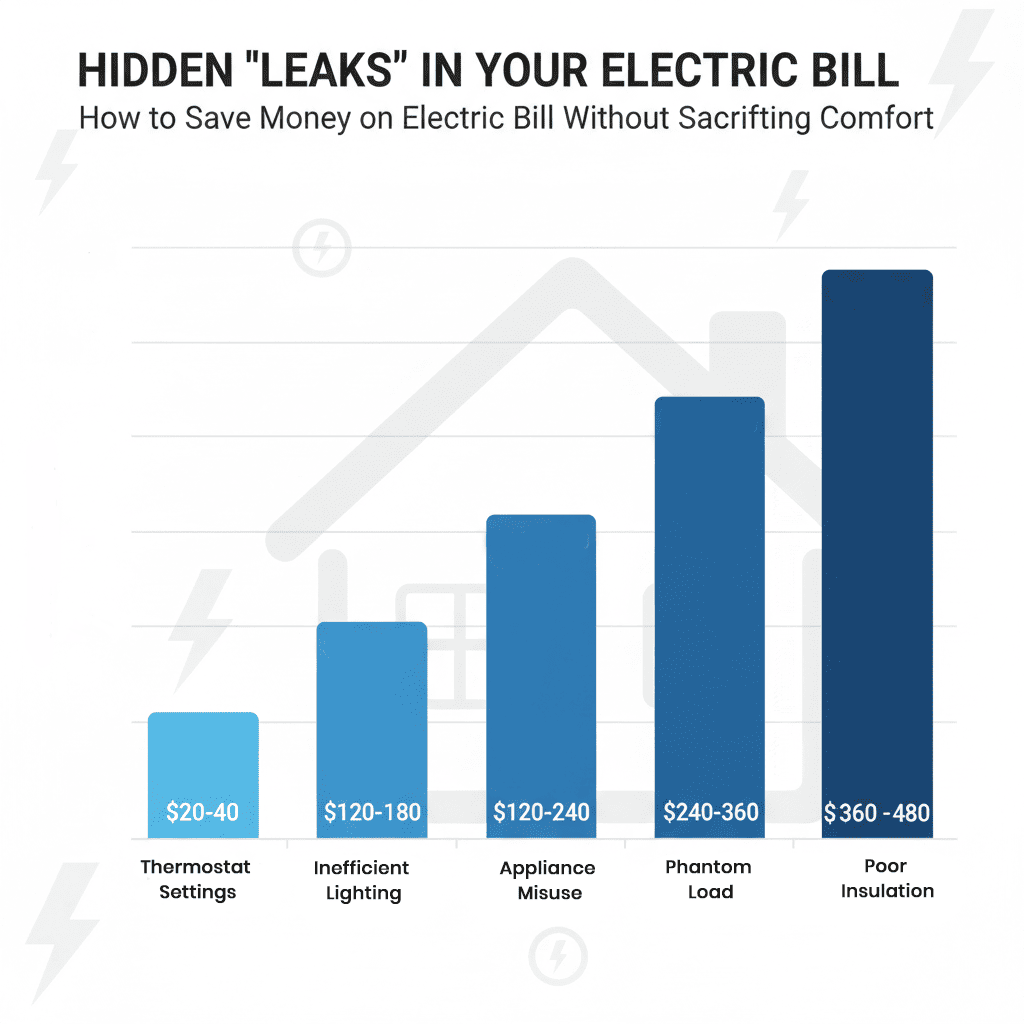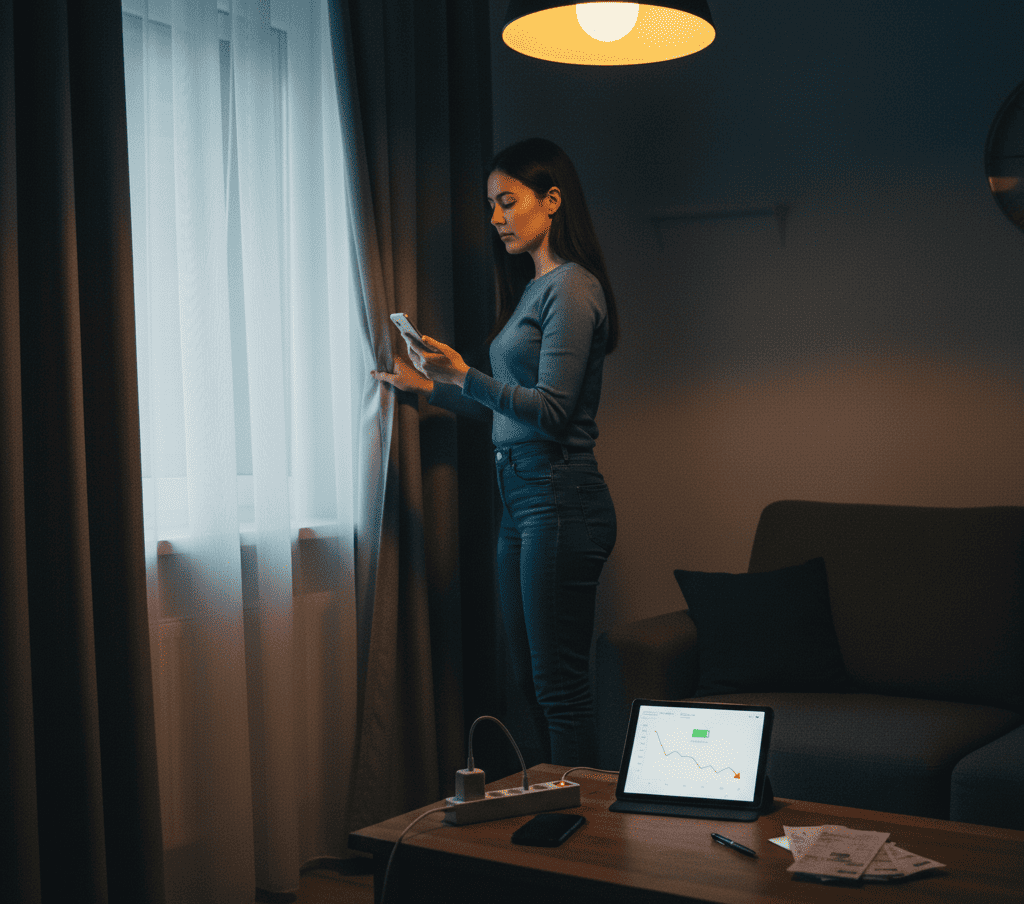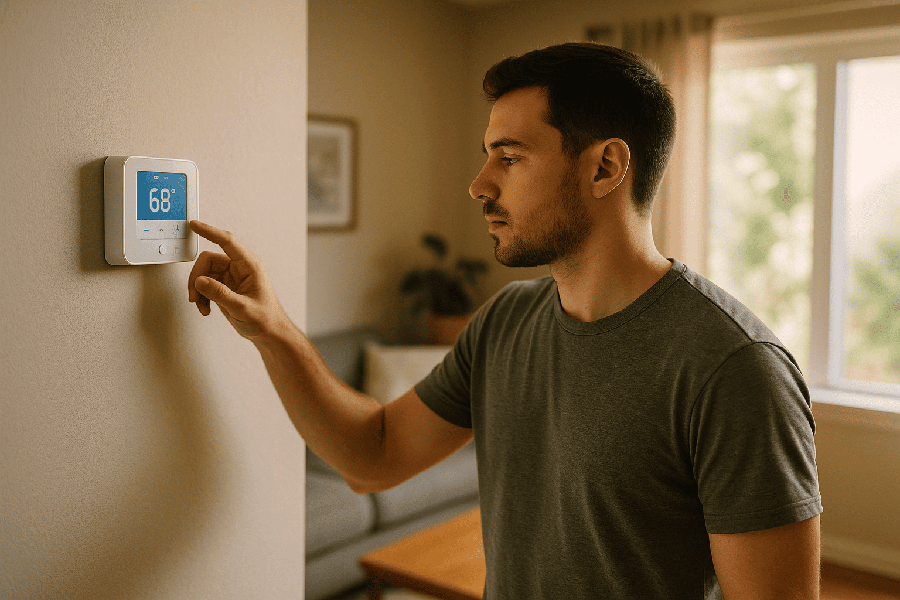Quick Quiz: What’s Your Power-Saving Style?
Answer step by step. Your result will appear at the end.
For most households, the electric bill is one of the most unpredictable monthly expenses. Even when income remains stable, power costs can rise unexpectedly due to seasonal changes, higher demand, or hidden inefficiencies at home. Many people believe electricity costs are fixed, but in reality, they are highly controllable with the right approach.
The key is understanding where electricity is consumed and applying targeted strategies to reduce waste. Saving money on energy is not about living in the dark or sacrificing comfort - it's about using smarter tools, creating efficient habits, and fixing the biggest “energy leaks.” With clear steps, the monthly bill can be reduced by 15-30% without major investments. This article explains proven ways to bring costs down and shows how families across the country are regaining control of their budgets.
Listen to the article - it is faster than reading!
Why Your Electric Bill Feels Out of Control?
An electric bill often feels overwhelming because most households focus only on the final amount, not the breakdown behind it. Power companies charge based on kilowatt-hours consumed, but several factors cause those numbers to climb. Heating and cooling usually account for nearly half of all usage, especially in homes with older HVAC systems or poor insulation. Appliances such as refrigerators, dryers, and dishwashers also consume more than people expect, particularly if they are outdated or poorly maintained.
Phantom loads - electricity consumed by devices left plugged in but not actively used - make up another hidden cost.
Gaming consoles, televisions, chargers, and cable boxes all draw power continuously, quietly raising monthly expenses. Seasonal changes add more complexity: summer air conditioning and winter heating can double or even triple the bill compared to spring or fall. Utility companies may also apply time-of-use pricing, which means running appliances at peak times leads to higher charges.
The combination of all these elements explains why bills feel unmanageable. However, once you understand the drivers, you can learn how to save on electric bill with simple, consistent changes that directly target the largest sources of waste.
Energy Leak Points: Where Households Overspend

Every household has hidden “leaks” that silently raise costs. Identifying these areas is the first step toward real savings. Many families don't realize that small inefficiencies add up to hundreds of dollars annually. Below are five common leak points with real-world examples of how much they cost. This knowledge helps answer the question: how can I save on electric bill effectively?
| Energy Leak | Explanation & Example |
| Phantom Load | Idle electronics such as TVs, gaming consoles, and chargers consume power 24/7. A single cable box can use $5-7 of electricity monthly, and across multiple devices, the total can reach $20-30. |
| Inefficient Lighting | Incandescent bulbs waste 75% more electricity than LEDs. Replacing ten bulbs with LEDs saves $10-15 each month, especially in households where lights stay on for long periods. |
| Thermostat Settings | Setting the thermostat just 3°F lower in winter or higher in summer can increase bills by $20-40. Without adjustments, HVAC systems overwork, inflating energy costs. |
| Appliance Misuse | Running half-full laundry loads or using the dishwasher during peak hours adds $10-20 monthly. Over a year, this habit costs more than $200. |
| Poor Insulation | Drafty windows and doors allow conditioned air to escape. Even small leaks can raise heating or cooling costs by $30-50 monthly. Weatherstripping or sealing dramatically reduces this waste. |
We are recommend
Appliance Power Usage Tracker
Do you want to understand what your powewr bill consists of?? Built for practical households, the Appliance Power Usage Tracker translates appliance choices into monthly kWh and dollars with transparent math. The Results table ranks costs line by line and surfaces expert actions - set water heaters to 120°F, enable auto-sleep on computers, batch laundry with high-spin, and cook efficiently with lids or a microwave for small portions. Add any custom device in seconds. Revisit after two weeks to confirm savings.
How to Save Money on Electric Bill? Practical Shifts That Work
Reducing electricity costs is not about cutting comfort - it's about smart adjustments that make your home run more efficiently. Small steps such as upgrading bulbs, unplugging idle devices, or sealing air leaks add up quickly. Each action alone may seem modest, but combined they generate noticeable reductions. Proven methods, backed by data and real household experiences, show how even renters can lower costs without major renovations. For those wondering how can I save money on electric bill, the answer lies in consistent application of these practical, evidence-based strategies.
Quick and Easy Tips
- Turn off unused lights and electrical devices. Even though a single bulb or device might consume a small amount of electricity, leaving multiple lights or electronics on throughout the day adds up quickly. Making it a habit to switch off lights when leaving a room or unplugging chargers when not in use can reduce unnecessary consumption. Over a year, these consistent habits can cut $20-$30 from your bill without any investment.
- Use LED bulbs. LED bulbs are up to 80% more energy-efficient than traditional incandescent bulbs. They also last up to 25 times longer, meaning fewer replacements and reduced costs. Replacing ten high-use bulbs in your home can lower your bill by $60-$100 annually, while improving lighting quality.
-
Open curtains during the day. Natural daylight is free and highly effective at reducing reliance on electric lighting. By opening curtains and blinds during
daylight hours, you decrease the need for artificial lighting and even gain some passive solar heat during colder months. This simple step lowers both lighting and heating
costs.
Appliance Habits
- Unplug or use smart plugs. Many devices continue to draw power even when switched off - a phenomenon known as phantom load. TVs, microwaves, and computer systems can consume electricity 24/7 if left plugged in. Using smart plugs to automatically cut power when devices are not in use can save around $45 per year.
- Run washing machines and dishwashers with full loads. Half-full loads waste both energy and water. Running these appliances only when full optimizes each cycle. Additionally, choosing lower temperature settings for laundry and dishwashing reduces energy consumption by up to 30%.
Heating and Cooling
- Lower your thermostat by 1 degree. Every degree makes a difference. Reducing your thermostat setting by just 1°C in winter can cut heating costs by up to 10%. In practical terms, this small adjustment saves households $50-$100 annually while remaining comfortable with layered clothing or blankets.
- Install a smart or programmable thermostat. Smart thermostats adapt to your routine, lowering heating or cooling when you're away and adjusting before you return. This prevents wasted energy and ensures efficiency. Households typically save $100-$150 annually with this upgrade, and many utility companies offer rebates that reduce upfront costs.
-
Draught-proof windows and doors. Poor insulation causes significant heat loss in winter and heat gain in summer. Draught-proofing with weatherstripping,
sealant, or heavy curtains prevents conditioned air from escaping. This reduces the workload on HVAC systems and lowers energy bills by $80-$150 per year.
Upgrades and Investments
- Consider solar panels. Solar energy drastically reduces reliance on grid electricity. Although installation involves upfront costs, long-term savings can be substantial, with monthly bills reduced by 50-80% in sunny regions. Subscription-based community solar programs are also available, making renewable energy more accessible without the initial expense.
-
Upgrade to energy-efficient appliances. High-consumption devices like refrigerators, freezers, and HVAC systems account for a large portion of your bill.
Replacing outdated models with Energy Star-rated appliances reduces electricity use by 10-30%. For example, a new refrigerator can save $80-$120 annually compared to a
15-year-old unit.
Day-to-Day Behaviors
- Don't overfill your kettle. Boiling more water than necessary wastes both energy and time. Filling the kettle only with the amount needed reduces electricity use and can save $20-$30 per year.
- Dress appropriately indoors. Instead of relying solely on heating or cooling systems, adjust your clothing to the season. Wearing layers in winter or lighter fabrics in summer helps maintain comfort at lower energy costs. This practice can indirectly cut $40-$70 from your annual bill.
- Wash laundry with cold water and clean filters. Washing with cold water eliminates the energy needed to heat water, which accounts for up to 90% of a washing machine's electricity use. Regularly cleaning filters in dryers and HVAC systems improves efficiency, preventing wasted energy. Together, these habits can save $60-$100 per year.
Professional Help
-
Request a home energy audit. Many utility companies offer free or subsidized energy audits. Professionals assess insulation, appliance efficiency, and heating
systems, then provide tailored recommendations. Following these insights typically saves households $100-$300 annually. An audit ensures you focus on the highest-impact changes
instead of guessing where to cut costs.
By consistently applying these strategies, you don't just reduce your bills - you build a more efficient, resilient, and eco-friendly household.
Checklist: Quick Wins to Save Money on Electric Bill
Reducing your electric bill doesn't always require major changes or expensive upgrades. In fact, some of the most effective savings come from small actions you can take right now. These quick wins are simple, practical, and proven to lower monthly costs without sacrificing comfort. The goal is to start small, see immediate results, and build momentum for bigger savings over time.
This checklist can be copied and applied today. Use it as a daily or weekly reminder, and you'll notice the difference in your next bill. Even completing just a few items consistently can put $50-$70 back into your pocket each month.
Real-Life Scenarios: Families Who Can Save Money on Electric Bill
Debunking Myths That Keep Bills High
Many families stick to outdated beliefs about electricity use. These myths prevent them from making effective changes. By separating fact from fiction, households can finally understand how to save money on an electric bill in realistic, measurable ways.
-
Myth 1: Turning off lights is enough.
Fact: Lighting is only 10% of the bill. Real savings come from HVAC management and appliance efficiency. LEDs help, but thermostat control and sealing drafts save far more. -
Myth 2: Lowering the thermostat drastically saves more.
Fact: Extreme adjustments strain systems and create discomfort. Moderate 2-3°F changes save $20-40 monthly without side effects. Smart thermostats automate the process efficiently. -
Myth 3: Unplugging devices doesn't matter.
Fact: Phantom load accounts for 5-10% of bills. Smart strips or unplugging idle electronics save $15-30 monthly with little effort. -
Myth 4: Only homeowners can cut bills.
Fact: Renters can save with LEDs, smart strips, thermal curtains, and efficient appliance use. These changes typically reduce bills by $30-60 monthly. -
Myth 5: New appliances don't pay off.
Fact: Energy Star appliances use 10-30% less energy. A new fridge alone saves $10-15 per month. With rebates, payback is faster than most expect.
Tools That Actually Help
Lowering electricity costs becomes easier with the right tools. These devices and programs have been tested, widely adopted, and recommended by experts. Each provides measurable results and works for both homeowners and renters.
- Smart Thermostats. Learn your schedule and adjust temperatures automatically. Save $20-35 monthly.
- Energy Monitors. Track real-time usage and reveal hidden drains. Families save $15-30 monthly by acting on the data.
- Solar Blinds or Home Solar Programs. Harness natural energy and reduce grid dependence. Savings vary from $20-50 monthly depending on system size.
- Utility Rebates and Efficiency Programs. Many providers offer free energy kits or rebates on appliances. Typical savings: $10-25 monthly.
- Smart Plugs and Power Strips. Eliminate phantom load and manage electronics remotely. Cut $10-20 monthly.
- LED and Smart Bulbs. Consume 75% less power than incandescent bulbs. Swapping ten bulbs saves $10-15 monthly.
Conclusion
Your electric bill is not a fixed cost - it's a system you can control. By identifying leaks, applying smarter habits, and using proven tools, households routinely save $40-$100 each month. Over a year, that's $500-$1,200 back in your budget.
The important part is starting small. Choose one action today - replace bulbs, adjust your thermostat, or unplug idle devices - and measure the difference on your next bill. Once you see results, add more strategies to multiply savings. Learning how to save money on electric bill is not just about cutting costs; it's about creating financial breathing room and stability. Begin today, and your next statement will prove the impact.
FAQ: Actionable Answers
Question 1. What's the fastest way to cut my electric bill this month?
Focus on habits with immediate impact: adjust the thermostat by 2-3°F, unplug idle electronics, and switch to LEDs in the most-used rooms. Run laundry and dishwashers only full and during off-peak hours. Seal at least one drafty window or door. These steps can reduce your bill by $40-70 right away.
Question 2. Do I need new appliances to lower electricity costs?
Not necessarily. Old appliances are inefficient, but you can save a lot without replacing them: clean fridge coils, set temperatures correctly, and use appliances strategically. However, upgrading to Energy Star appliances brings long-term savings, often $10-20 monthly per device. Balance immediate habits with future upgrades for best results.
Question 3. How can renters realistically save on electric bills if they can't renovate the property?
Renters often assume they cannot reduce electricity costs because major renovations are out of reach. However, many low-cost, renter-friendly changes make a noticeable difference. Replacing incandescent bulbs with LEDs, using smart plugs to cut phantom load, and sealing windows with removable draft stoppers are all simple but effective. Thermal curtains help regulate temperature, lowering both heating and cooling demands. Running appliances at night on off-peak pricing adds further savings. Even without altering the property, renters can save $30-60 per month with these steps. The key is consistency - building daily habits and using small tools that don't require landlord approval.
Question 4. Should I focus more on heating/cooling or lighting to reduce electricity bills?
Both matter, but heating and cooling should be your first priority. HVAC systems often account for 40-50% of total household electricity use, while lighting is typically around 10%. Adjusting your thermostat by 2-3°F, sealing drafts, and using ceiling fans correctly can save $40-70 per month. Lighting upgrades, like switching to LEDs, add another $10-15 monthly. The smart strategy is to combine them: tackle the biggest load (HVAC) first, then eliminate smaller inefficiencies like old bulbs and phantom load. This layered approach maximizes savings without compromising comfort.
Question 5. Are solar panels or solar programs really worth it for lowering bills?
Solar panels require an upfront investment, but for many households they pay off in the long run. A well-sized system can cut 50-90% of your bill, depending on location and sunlight hours. Many utilities also offer solar buyback programs, where you earn credits for excess power sent to the grid. For those who cannot install panels, solar subscription programs or community solar farms provide access with little or no upfront cost. Whether panels or programs, the value lies in reducing reliance on grid electricity. For households with high monthly bills, solar can provide savings of $50-$100 monthly once installed.
Question 6. What's the best way to track whether my power-saving efforts are working?
The easiest method is to compare monthly bills before and after changes. However, a more accurate way is to track kilowatt-hour usage instead of just dollar amounts, since rates can fluctuate. Many utility companies offer online dashboards where you can see daily or hourly consumption. For greater control, home energy monitors like Sense or Emporia provide real-time data on specific appliances. By logging adjustments - such as thermostat changes, new LED bulbs, or unplugged devices - you can directly connect habits with reduced usage. Tracking ensures motivation: seeing $40 less on a bill confirms your efforts are paying off.






